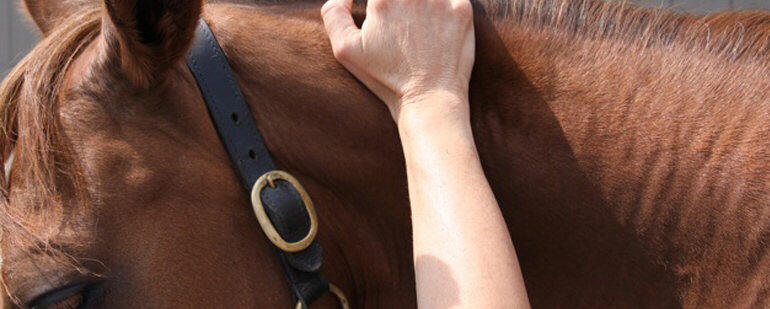|
CASE STUDY: Resistant Bending Left on a Circle, Short in Right
Front Going Left on a Circle and Short in Right Front in a Straight
Line.
Problem in Motion as Reported by Rider:
Carla was a bit upset when she was lunging her
horse to the left and he appeared short in the right front on the circle.
Following the lunging, she rode him in a straight line and asked him
to do shoulder in to the left. He felt short in the right front on a
straight line, and resistant bending to the left. She immediately thought
he might have a high suspensory problem or some other soft tissue problem
behind the lower leg. Carla typically jumps to the worse case scenario
first, rather than going from a simple problem and solution, to the
most serious on the continuum. I think she does this because she is
in vet school and see’s more serious lameness issues.
Carla called me stating “I am going to start
with you first because I cannot face the probability that the problem
is a deeper soft tissue structure behind the lower leg, requiring months
of rest”. I assured her that if he was not lame, and just a bit short,
we might want to rule out a muscular problem first. If after I worked
on the horse and he did not resume a normal gait or was lame, then her
vet needed to be called. I suggested it may very well be of a muscular
nature because when a muscle is tight it is resistant to a specific
movement. Good motion should come easily. If there is any resistance
or shortness, then I usually suspect simple muscle tightness as the
cause of the motion problem.
Evaluation and Assessment:
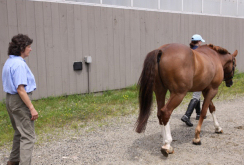 I
carefully looked at the horse’s body and legs to see any evidence of
an injury including swelling or cuts. I did not see anything that suggested
an injury. I then asked Carla to walk her horse in a straight line away
from me and then toward me. I get the best view of muscle function at
the walk. The slower the horse moves, the more muscle is used without
momentum. After I listened to Carla’s description of the motion problem,
I began assessing the horse using palpation of the major muscles with
my hands. I
carefully looked at the horse’s body and legs to see any evidence of
an injury including swelling or cuts. I did not see anything that suggested
an injury. I then asked Carla to walk her horse in a straight line away
from me and then toward me. I get the best view of muscle function at
the walk. The slower the horse moves, the more muscle is used without
momentum. After I listened to Carla’s description of the motion problem,
I began assessing the horse using palpation of the major muscles with
my hands.
Findings:
At the walk, I could clearly see the horse was
short and labored in bringing his right leg forward. He was not bringing
his leg back or forward freely. He looked short at the point of the
right shoulder. I felt severe tightness in the right lower neck where
it joins in with the point of the shoulder and forearm. The muscle is
named the brachiocephalicus muscle. <illustration> It has a big name,
and a big job. It ‘s job is to bring the leg forward when the head and
neck are straight, as well as flex, or bend the neck to the same side
of the contraction. After thorough palpations, I found compensatory
tightness in the horse’s left gluteal muscles. Since the dynamics of
motion occur on a diagonal, it is common to find the opposite hind leg
tight in relation to limited motion in a front leg. The horse will always
tighten the opposite hind leg to balance and adjust to the compromised
motion in the opposite front end.
Solution and Treatment:
After determining the specific muscle tightness,
I applied the Wilson Meagher Method of sportsmassage. I started with
compressions along the entire brachiocepalicus which lies chiefly along
the entire neck from the poll to the point of the shoulder. It is found
near the base of the neck and not up toward the mane. Since the muscle
was so tight, I initially used compressions with a very loose fist to
separate the muscle fibers and bring more blood to the area in order
to soften the muscle. If I used direct pressure and cross fiber friction,
two of the other techniques of the Wilson Meagher Method, first, the
horse would feel pain and discomfort and resist the treatment. I then
used cross fiber friction where the neck meets the point of the shoulder.
I needed to use soft and slightly flexed finger’s as this area was extremely
tight and uncomfortable. I gently crossed the muscle fibers back and
forth at the base of the neck softening and widening the fibers. After
a minute, this lower part of the muscle softened and the horse seemed
relieved. It is important to observe the horse’s reaction to the application
of the technique.
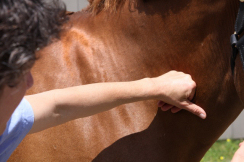 Horse’s
behavior will always instruct as to how much pressure and which technique
works best. If a horse moves away, or tries to bite or kick, then it
is too much pressure, too intense, or too painful. If this behavior
occurs, then back off, and work somewhere else on the horse where the
treatment is tolerated. Horse’s
behavior will always instruct as to how much pressure and which technique
works best. If a horse moves away, or tries to bite or kick, then it
is too much pressure, too intense, or too painful. If this behavior
occurs, then back off, and work somewhere else on the horse where the
treatment is tolerated.
With a soft and open fist, I used compressions
on the entire neck, and specifically on the brachiocephalicus. Never
use knuckles or an elbow because the pressure can be too intense and
you cannot feel with knuckles or an elbow. It is important to feel the
tissue change and soften. Once you feel the tissue soften, stop the
work and work elsewhere. It is like the Law of Diminished Returns. If
you overdo, and work the area too hard, with too much intensity or too
long, the horse may become sore and uncomfortable after the work. Less
is more.
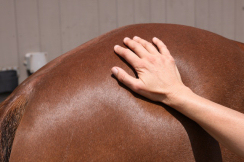 After
working on the brachiocephalicus, I worked on the entire horse particularly
on the compensatory tightness in the opposite left hind leg. The compensatory
muscles were the gluteals and hamstrings of the left hind. Using an
open hand and with the heel of my hand, I performed compressions on
the entire hind end and rest of the horse. Compressions are a rhythmical
pumping action similar to cardio pulmonary resuscitation. Always work
down toward the ground applying the compressions toward the bone where
the muscle is attached. After
working on the brachiocephalicus, I worked on the entire horse particularly
on the compensatory tightness in the opposite left hind leg. The compensatory
muscles were the gluteals and hamstrings of the left hind. Using an
open hand and with the heel of my hand, I performed compressions on
the entire hind end and rest of the horse. Compressions are a rhythmical
pumping action similar to cardio pulmonary resuscitation. Always work
down toward the ground applying the compressions toward the bone where
the muscle is attached.
Once the horse’s muscle’s felt softer and more
pliable, I stopped the treatment and asked Carla to follow up by riding
the horse after my work, in a long and low, but connected frame at the
canter. When I say connected, I mean riding the horse from back to front
and in to your hand and not just flopping loosely on the forehand. I
do not want the horse to be collected for this exercise. The canter
is the most concerted exercise at lengthening all of the muscle groups.
That is why the trot always feels better after the canter. I wanted
the horse to canter because the exercise becomes part of the treatment.
The canter and exercise further lengthens the muscle fibers and brings
more blood and oxygen to the tissue to complete the treatment. The Wilson
Meagher Method of Sportsmassage prepares the muscles to be used. It
is sports massage therapy. It is not meant to rest the horse. However,
it is not a perfect world. If a person does not have time to exercise
the horse right away or until the next day, that is fine. It is the
second best solution. We all usually do the best we can for our horses.
Cause and Summary:
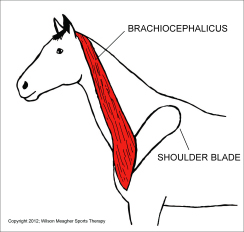 The
brachiocephalicus’s job is to advance the leg forward when the head
and neck are straight extending the shoulder joint, and to bend the
head and neck toward the same side. Muscle tightness is caused by an
injury, overuse, or diminished oxygen. Carla’s horse was tight in the
right brachicephalicus causing the horse to be resistant bending to
the left. Also, the tightness did not allow the front leg to move back
and forth freely. Muscle tightness effect’s the release process, or
the letting go, of the muscle. For instance if a muscle’s job is to
bring a leg forward, then the muscle must be loose enough to allow for
the leg to go backward. In Carla’s horse, the muscle in the right neck
was so tight, it was not releasing or letting go, for the neck to bend
to the left. Also, since the brachiocephalicus muscle brings the leg
forward, it was not releasing for the leg to go backward easily so the
horse appeared off in the right front. When the horse was on a circle
traveling to the left, the right brachiocepahlicus was so tight, it
did not allow for the horse to bring his leg around and bend freely
to the left with his neck. Therefore the horse looked short on the circle
in the right front going left. The
brachiocephalicus’s job is to advance the leg forward when the head
and neck are straight extending the shoulder joint, and to bend the
head and neck toward the same side. Muscle tightness is caused by an
injury, overuse, or diminished oxygen. Carla’s horse was tight in the
right brachicephalicus causing the horse to be resistant bending to
the left. Also, the tightness did not allow the front leg to move back
and forth freely. Muscle tightness effect’s the release process, or
the letting go, of the muscle. For instance if a muscle’s job is to
bring a leg forward, then the muscle must be loose enough to allow for
the leg to go backward. In Carla’s horse, the muscle in the right neck
was so tight, it was not releasing or letting go, for the neck to bend
to the left. Also, since the brachiocephalicus muscle brings the leg
forward, it was not releasing for the leg to go backward easily so the
horse appeared off in the right front. When the horse was on a circle
traveling to the left, the right brachiocepahlicus was so tight, it
did not allow for the horse to bring his leg around and bend freely
to the left with his neck. Therefore the horse looked short on the circle
in the right front going left.
Carla and I discovered why her horse was so tight
in the right neck. The horse had a habit of pawing with the right front
leg. Carla had been to a competition for three days and the horse sat
in the trailer each day for many hours while Carla competed her other
horses. The horse simply pawed most of the time he was on the trailer.
He was on the trailer for six hours each day. This was enough to create
tightness in his neck which created the shortness in his right leg and
lack of flexibility and bend to the left.
After Carla rode her horse, she was beaming.
He was moving evenly in the front and was able to bend in both directions
freely. She was so relieved it was not a deeper problem, she suggested
we have a toast with a glass of wine! With another four more horse’s
for me to work on, I had to refuse the offer, but it sure sounded like
a good idea!
|
|
